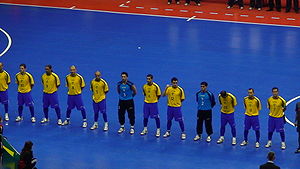Wednesday 17 August 2011
Plans
website plans
Futsal is a variant of association football that is played on a smaller pitch and mainly played indoors. Its name is derived from the Portuguese futebol de salão and the Spanish fútbol de salón (colloquiallyfútbol sala), which can be translated as "hall football" or "indoor football". During the sport's second world championships held in Madrid in 1985, the name fútbol de salón was used. Since then, all other names have been officially and internationally changed to futsal.
Futsal is played between two teams each with five players, one of whom is the goalkeeper. Unlimited substitutions are permitted. Unlike some other forms of indoor football, the game is played on a hard court surface delimited by lines; walls or boards are not used. Futsal is also played with a smaller ball with less bounce than a regular football.[1] The rules create an emphasis on improvisation, creativity and technique as well as ball control and passing in small spaces.[2d in Montevideo, Uruguay, in 1930, when Juan Carlos Ceriani created a version of football for competition in YMCAs. In Brazil, this version developed on the streets of São Paulo, and, eventually, a rule book was published. The sport began to spread across South America, and its popularity ensured that a governing body was formed under the name of FIFUSA (Federación Internacional de Fútbol de Salón) in 1971, along with the World Championships. The first World Championships were held in Río de Janeiro, with hosts Brazil crowned champions ahead of Paraguay. Even more countries participated in the second World Championships held in Las Vegas in early 2000's.[3] Due to a dispute between FIFA and FIFUSA over the administration of fútbol, FIFUSA coined the word fut-sal in 1985.
FIFA took control of the World Championships in 1989. Under new rules made by FIFA, the technical aspects of the game for players and spectators were improved. The linesmen were replaced with a second referee, and there were unlimited substitutions.[4] It also introduced a size 4 football, which was weighted to reduce bounce by 30% compared to a conventional ball, which enabled faster play and, for the first time, scoring goals with the head.[3][5]
FIFA's relationships with its member associations allowed more countries to gain knowledge and resources about futsal.[3] FIFA soon began to administer its own indoor football games, hosting its first FIFA Indoor Soccer World Championship in 1989 inRotterdam, Netherlands. In 1992, it was the FIFA Five-a-Side World Championship (Hong Kong), and, since 1996, it has been called the FIFA Futsal World Championship. Thanks to the increase of the number of nations that participated in the FIFA Futsal World Championships held in 2000, Brazil's dominance in the competition was ended by Spain.[3]
In 2004, members of PANAFUTSAL (La Confederación Panamericana de Futsal, The Pan-American Futsal Confederation) formed AMF (Asociación Mundial de Fútbol de Salón, World Futsal Association), an international futsal governing body independent of FIFA. Both FIFA and AMF continue to administer the game.[6] As international governing bodies of futsal, FIFA and AMF are responsible for maintaining and promulgating the official rules of their respective versions of futsal. Like football, futsal has laws that define all aspects of the game, including what may be changed to suit local competitions and leagues. There are seventeen laws in the Futsal Laws of the Game.[7]
[edit]Players, equipment and officials
 The Brazil national futsal team line up before a match.
The Brazil national futsal team line up before a match.There are five players on each team, one of whom is the goalkeeper. The maximum number of substitutes allowed is seven, with unlimited substitutions during the match. Substitutes can come on even when the ball is in play.[8] If a team has fewer than three players in the team, the match is abandoned.[9]
The kit is made up of a jersey or shirt with sleeves, shorts, socks, shinguards made out of rubber or plastic, and shoes with rubber soles. The goalkeeper is allowed to wear long trousers and a different coloured kit, to distinguish himself from the other players in the team and the referee. Jewellery is not allowed, as are other items that could be dangerous to the player wearing the effects or to other active participants.[10]
The match is controlled by a referee, who enforces the Laws of the Game, and the first referee is the only one who can abandon the match because of interference from outside the pitch. This referee is also assisted by a second referee. The decisions made by the referees are final and can only be changed if the referees think it is necessary and play has not restarted.[11] There is also a third referee and a timekeeper, who are provided with equipment to keep a record of fouls in the match. In the event of injury to the referee or second referee, the third referee will replace the second referee. [12]
[edit]

